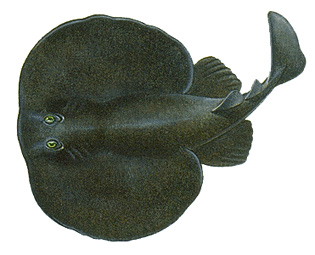Electric ray is a type of fish that can give off electricity. They live on the bottom of warm seas. Most electric rays are found in shallow coastal water, but some live as deep as 1,200 feet (370 meters). There are dozens of species (kinds).

Electric rays have a flat, wide body and a slender, pointed tail with fins. Their colors vary, but most species are dark brown, blue, or gray with spots. Electric rays measure from 6 inches to 7 feet (15 to 215 centimeters) long. Two special organs on the upper side of the head allow the fish to give off electricity. The skin follows the honeycomb shape of the electric organs it covers.
Electric rays produce electric charges to defend themselves and to stun their prey. They eat shellfish, worms, and other small fish. The shock from a full-grown, healthy ray can stun a human being.
Electric rays are not as active as most other fish. Many cover themselves with sand or mud and remain mainly stationary or swim slowly at the sea bottom. The eggs of most fish hatch outside the female’s body, but female electric rays hatch their eggs inside their bodies and so give birth to live young.
